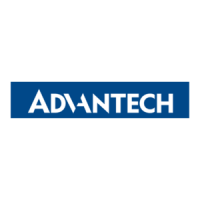ADAM-4000 Series User Manual 168
4011, 4011D, 4012
5.3.11 @AACE
Name Clear Event Counter command
Description The addressed module is instructed to reset its event counter to zero.
Syntax @AACE(cr)
@ is a delimiter character.
AA (range 00-FF) represents the 2-character hexadecimal
address of an analog input module.
CE is the Clear Event Counter command.
(cr) represents terminating character, carriage return (0Dh).
Response !AA(cr) if the command was valid.
There is no response if the module detects a syntax error or
communication error or if the specified address does not exist.
! delimiter character indicates a valid command was received.
AA represents the 2-character hexadecimal address of the
responding analog input module.
(cr) represents terminating character, carriage return (0Dh).
Example command: @09CE(cr)
response: !09(cr)
The command instructs the module at address 09h to set its
event counter to zero. The module responds that its counter
has been reset.
5.4 Excitation Voltage Output Command Set
Command Syntax Command Name Description I/O module
$AA6 Get Excitation Voltage
Output Value
Returns either last value sent
to specified module by $AA7
command, or start-up output
voltage.
4016
$AA7 Excitation Voltage
Output
Direct output excitation
voltage data to a specified
module
4016
$AAS Start-up Voltage Output
Configuration
Stores a default value in a
specified module. The output
value will take effect upon
startup.
4016
$AAE Trim Calibration Trims specified module a
number of units up/down
4016
$AAA Zero Calibration Tells the module to store
parameters for zero calibration
4016
$AAB Span Calibration Tells the module to store
parameters for span calibration
4016

